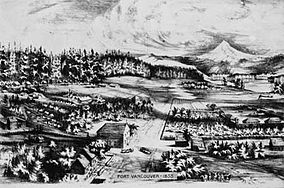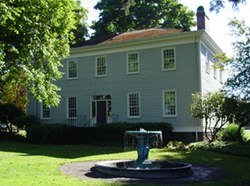Fort Vancouver National Historic Site
| Fort Vancouver National Historic Site | |
|---|---|
IUCN category V (protected landscape/seascape) | |
 Illustration of Fort Vancouver and its environs in 1855. | |
| Location | Vancouver, Washington and Oregon City, Oregon, USA |
| Nearest city | Vancouver, Washington, and Oregon City, Oregon |
| Coordinates | 45°37′31″N 122°39′29″W / 45.6253950°N 122.6581525°W[1] |
| Area | 194 acres (79 ha) [2] |
| Established | June 19, 1948 (national monument) June 30, 1961 (national historic site) |
| Visitors | 1,017,326 (in 2009)[3] |
| Governing body | National Park Service |
Fort Vancouver National Historic Site is a United States National Historic Site located in the states of Washington and Oregon. The National Historic Site consists of two units, one located on the site of Fort Vancouver in modern-day Vancouver, Washington; the other being the former residence of John McLoughlin in Oregon City, Oregon. The two sites were separately given national historic designation in the 1940s.[4] The Fort Vancouver unit was designated a National Historic Site in 1961, and was combined with the McLoughlin House into a unit in 2003.
Fort Vancouver site
The main unit of the site, containing Fort Vancouver, is located in Vancouver, Washington, just north of Portland, Oregon. Fort Vancouver was originally an important 19th century fur trading outpost that was established in 1824 by the British Hudson's Bay Company (HBC), under the command of chief factor John McLoughlin. It was the center of activity on the Pacific coast and its influence stretched from the Rocky mountains in the east, to Alaska in the north, Mexico in the south, and to Hawaii in the Pacific. Then in 1843, the Hudson's Bay Company, in the face of increasing US settlement, moved their base of operations in the region to Fort Camuson, now known as Fort Victoria in what is now Victoria, British Columbia. In 1846 the Treaty of Oregon was ratified, and Fort Vancouver became part of the Oregon Territory of the United States. The Treaty permitted HBC to continue to operate the Fort Vancouver site even after the boundary dispute was settled, but they eventually abandoned the post in 1860.
In 1849, the United States Army constructed a barracks adjacent to the British trading post; and took over the Hudson's Bay facility when it was abandoned. A fire destroyed the fort itself in 1866, but the Army facility has continued in operation in various forms down to the present.
Fort Vancouver was separated from the Army's barracks and became a national monument in 1948. Congress expanded the protected area in 1966 and re-designated the site as a National Historic Site. For some years after its addition to the National Park System, the National Park Service was reluctant to begin reconstruction of the fort walls or buildings, preferring to manage it as an archaeological site as provided by its standing policies. However, in 1965, with the urging of the local community, Congress directed reconstruction to begin. All fort structures seen today are modern replicas, albeit carefully placed on the original locations.[5] In response to concerns about the designation of reconstructed structures, the Park Service designated the Vancouver National Historic Reserve Historic District to encompass reconstructed buildings as well as historic Army and Mission 66 era Park Service structures.[6]
McLoughlin House site
McLoughlin House National Historic Site | |
 | |
| Location | McLoughlin Park, between 7th and 8th Sts., Oregon City, Oregon |
|---|---|
| Area | 0.6 acres (0.24 ha) |
| Built | 1845 |
| NRHP reference No. | 66000637[7] |
| Significant dates | |
| Added to NRHP | October 15, 1966 |
| Designated NHS | 1941 |
The McLoughlin House unit consists of the homes of McLoughlin, and of Dr. Forbes Barclay, an explorer and associate of McLoughlin's; the two homes are known respectively as the McLoughlin House and the Barclay House. They are located adjacent to each other on a bluff overlooking the Willamette River in Oregon City, Oregon, on a plot of land set aside for public use by McLoughlin in the 1840s.[8]
In 1846, McLoughlin left the employ of Hudson's Bay Company, and purchased from the company a land claim located on the Willamette River in Oregon City. McLoughlin constructed the house there, and lived there until his death in 1857.[9] The house, a two-style colonial mansion, is typical of East Coast residences from the time.[10]
After McLoughlin's death in 1857, his widow lived there until she died three years later; their heirs sold the house in 1867. The home soon became a bordello known as the Phoenix Hotel. In 1908, the paper mill that owned the property wished to expand and the house was threatened with demolition, but preservationists saved it the next year. The house was moved from the riverfront to its current location on a bluff overlooking downtown Oregon City in 1910. It sat there for twenty-five years, until restored in 1935-1936 under the auspices of the Civil Works Administration, and opened as a museum.[10]
The Barclay House was built in 1849 by Portland carpenter and pioneer John L. Morrison, and occupied by Dr. Barclay and his family. Barclay died in 1874; the house remained in the family's possession until 1930 when it was moved from the waterfront to its present location, next to the McLoughlin House. Today, the Barclay House contains museum offices and a gift shop.[11]
The McLoughlin House became a National Historic Site in 1941, and both homes were added to the National Park System in 2003, becoming part of the Fort Vancouver National Historic Site.[9][12] The McLoughlin House unit lies on the Oregon National Historic Trail, a part of the National Trails System. The graves of McLoughlin and his wife are on the premises.[13] The house contains both original and period furnishings.
Gallery
-
The master bedroom of the McLoughlin House
-
Reconstructed buildings and palisade wall on the site of Fort Vancouver
-
Children's beds in the Douglas apartment of the Chief Factor's House
See also
- Officers Row, a district of historic U.S. Army structures adjacent to Fort Vancouver National Historic Site
- Pearson Field, adjacent to Fort Vancouver and a component of the National Historic Reserve
- Fort Langley National Historic Site, a preserved HBC fort in British Columbia
References
- ^ "Fort Vancouver National Historical Site". Geographic Names Information System. United States Geological Survey, United States Department of the Interior.
- ^ "Listing of acreage – December 31, 2010" (XLSX). Land Resource Division, National Park Service. (National Park Service Acreage Reports)
- ^ "NPS Annual Recreation Visits Report". National Park Service.
- ^ "Fort Vancouver: Cultural Landscape Report". National Park Service. Retrieved 2007-10-23.
- ^ "Fort Vancouver National Historic Site: Draft General Management Plan". National Park Service. October 2002. Retrieved 2007-10-28..
- ^ "HBCo. Blacksmith Shop". List of Classified Structures. National Park Service. 2008-11-18.
- ^ "National Register Information System". National Register of Historic Places. National Park Service. March 13, 2009.
- ^ "McLoughlin House". End of the Oregon Trail.
- ^ a b "The McLoughlin Memorial Association". Retrieved 2007-10-26.
- ^ a b Richard Engeman. "Residence of Dr. John McLoughlin, Oregon City". Oregon History Project. Oregon Historical Society. Retrieved 2007-10-26.
- ^ "Barclay House". The McLoughlin Memorial Association. Retrieved 2007-10-26.
- ^ PL 108–63, July 29, 2003, 117 Stat. 872, accessed at "U.S. Code Collection". Cornell University Law School, Legal Information Institute. Retrieved 2007-10-27.
{{cite web}}: Cite has empty unknown parameter:|coauthors=(help) - ^ "Fort Vancouver National Historic Site - McLoughlin House". National Park Service. Retrieved 2007-10-23.
External links
- IUCN Category V
- Forts in Washington (state)
- Forts in Oregon
- National Historic Sites in Washington (state)
- National Historic Sites in Oregon
- Fur trade
- Buildings and structures in Oregon City, Oregon
- History of Vancouver, Washington
- Historic house museums in Oregon
- Museums in Clark County, Washington
- Museums in Clackamas County, Oregon
- Military and war museums in Washington (state)
- Houses in Clackamas County, Oregon
- Parks in Clark County, Washington
- Parks in Clackamas County, Oregon





